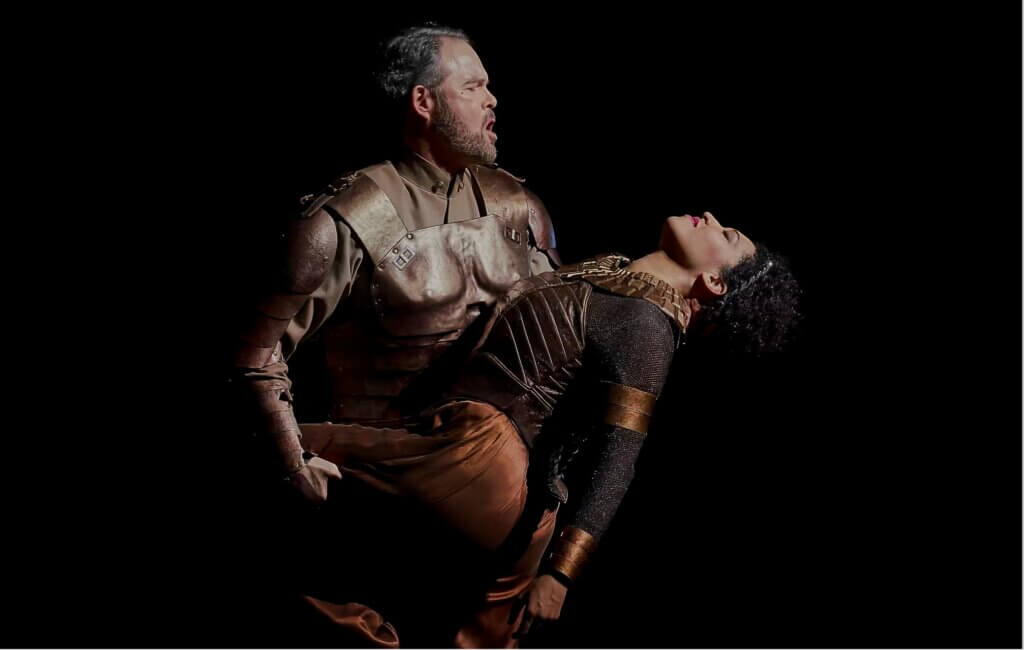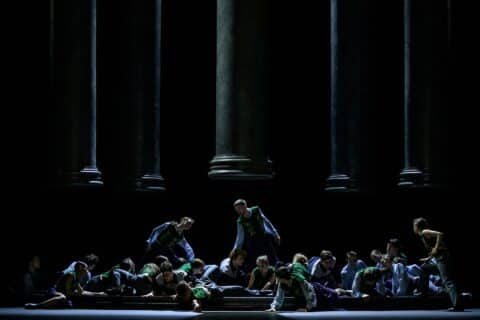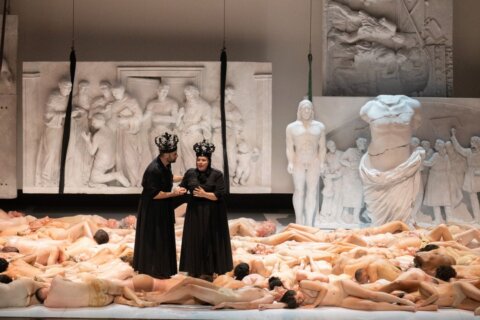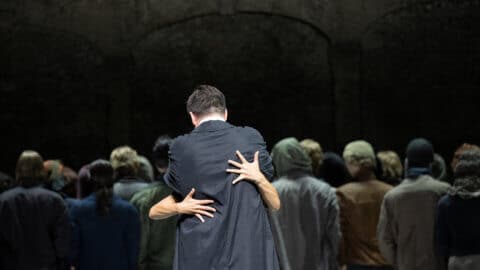ANTHONY & CLEOPATRA • BARCELONA LICEU
★★★★★☆

Photo: David Ruano
REVIEW ANTHONY & CLEOPATRA: HIGH INTENSITY EUROPE PREMIERE OF NEW OPERA BY JOHN ADAMS
The set design explodes in thunderous video projections of detonating artillery and anti-aircraft fire blown up on sliding set pieces as opera chorus and extras in combat uniforms take over the Opera Liceu in Barcelona in a sensory bombardment of musical accompaniment. Welcome to the five-star European premiere of Anthony & Cleopatra by American contemporary opera composer John Adams.
The story of Anthony and Cleoptra is so colorful, you’d hardly believe it’s true. In fact, it’s almost as if you’re in a tabloid version of The Beckhams from ancient times.
After the assassination of Julius Caesar, Antony was among those who cleaned up the system, and power over the Roman Empire ended up being shared between him and Octavian.
Antony took care of the eastern part of the empire, including Egypt, where he fell in love with Queen Cleopatra, with whom he had a good working relationship, even after office hours.
The relationship with Octavian slowly deteriorated and to patch things up, it was agreed that Antony would marry Octavian’s sister. A grandly staged manifestation of inner unity that, of course, didn’t deliver what it promised.
Soon Antony was back in Cleopatra’s arms. Octavian sent the Roman fleet to put the celebrity lovebirds in their place, and in a major battle at Actium off the coast of Greece with around 500 warships and 80,000 soldiers on each side, Antony and Cleopatra’s combined forces were emphatically defeated.
Beaten, humiliated and dishonored, Antony saw no other option but to commit suicide by his own sword.
Cleopatra’s bond of love was so strong that she too chose to die. In true tabloid fashion, she did so on the edge of the exotic by allowing herself to be bitten by a poisonous snake. Liebestod long before Wagner had institutionalized the concept.
The story has obvious film and stage drama potential and has been told in plays by Shakespeare and in Hollywood blockbusters starring Elizabeth Taylor and Richard Burton.
John Adams’ opera is based on a modern adaptation of Shakespeare’s interpretation. It is tightly packaged in two intense acts where time flies and events unfold in a highly energetic multimedia stage design by director Elkhanah Pulitzer.
The plot, essentially a love and power triangle, is set in a 1930s Hollywood glitzy time zone, opening with Cleopatra being pampered with pedicures and martinis in a beach club on the banks of the Nile.
Back in Rome the intrigue is framed in an air of Mussolini, ably aided by black and white video projections of mass fascist marches with the boss at the center.
It is cleverly put together and executed through a cunning, metallic curtain that, like a mixture of a Christmas calendar and a camera shutter, can partially open and create spaces up, down, right, left. A highly refined stage technique.
The second act opens with a golden sunset over the Nile’s flowing waters as the Liceu’s compelling orchestra plays out a bold pastiche of Wagner’s 136-bar Rhine Gold Overture in Adams’ modernist idiom. A musical treat and thunderous applause from the packed hall.
John Adams’ music is usually characterized by his contemporary style, combining an almost cinematic score with electronica – repetitive figures and patterns, often with synthesizers in the orchestra pit.
In this work, however, Adams seems to have taken a more conventional approach. and may disappoint aficionados looking for a more daring exploration of the boundaries of modern opera music.
The overall impression is one of grand scale, with spectacular set design, mass choreography and impressive costumes. Musically, however, the opera seems little less ‘different’ than his dazzling Nixon in China, which was an eye-opener when I saw it (twice) at the Copenhagen Opera House.
Assured performances are given by young American soprano Julia Bullock (Cleopatra) and Canadian bass-baritone Gerald Finley (Anthony). Perhaps best is tenor Paul Appleby with an anxiety-inducing, cold sound as Octavian, who may mirror Mussolini, but almost looks like Berlusconi.
The work was commissioned by the San Francisco Opera on the occasion of their 100th anniversary and produced in collaboration with The Met in New York and the Liceu.
Opera pings from all over Europe made the pilgrimage to the Catalan capital and Got To See This Se was among those invited. John Adams himself conducted the premiere, which developed into a memorable, five-star opera evening with a rousing tribute to the composer.




